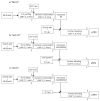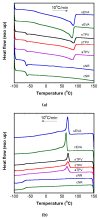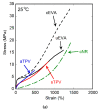Effect of Mixing Method on Properties of Ethylene Vinyl Acetate Copolymer/Natural Rubber Thermoplastic Vulcanizates
- PMID: 32759806
- PMCID: PMC7464805
- DOI: 10.3390/polym12081739
Effect of Mixing Method on Properties of Ethylene Vinyl Acetate Copolymer/Natural Rubber Thermoplastic Vulcanizates
Abstract
Thermoplastic vulcanizate (TPV) has excellent elastomeric properties and can be reprocessed multiple times. TPV is typically produced by using the dynamic vulcanization (DV) method in which rubber is crosslinked simultaneously with thermoplastics. Peroxide-crosslinked TPV can increase the compatibility between rubber and thermoplastics but loses its reprocessability due to excess crosslinking in the latter. In this work, we overcome this obstacle by using a two-step mixing method to prepare fully crosslinked elastomers of ethylene vinyl acetate copolymer (EVA) and natural rubber (NR). Each sample formulation was prepared with three different mixing methods for comparison: NR-DV, Split-DV, and All-DV. For NR-DV, NR was crosslinked prior to the addition of EVA together with the thermal stabilizer (TS). For Split-DV, a small amount of EVA and NR was crosslinked prior to the addition of EVA and TS. In the All-DV method, EVA and NR were crosslinked, and then TS was added. The appearance and processability of the samples were affected by the degree of crosslinking. NR-DV showed a non-homogeneous texture. Although the samples of the All-DV method appeared homogeneous, their mechanical and rheological properties were inferior to those of the Split-DV method. The mechanical properties of the Split-DV samples were not significantly changed after reprocessing 10 times. Therefore, Split-DV is the preferred method for TPV production.
Keywords: capillary rheometer; dynamic vulcanization; ethylene vinyl acetate copolymer; mixing method; natural rubber; thermoplastic vulcanizate.
Conflict of interest statement
The authors declare no conflict of interest.
Figures











References
-
- Maris J., Bourdon S., Brossard J.-M., Cauret L., Fontaine L., Montembault V. Mechanical recycling: Compatibilization of mixed thermoplastic wastes. Polym. Degrad. Stab. 2018;147:245–266. doi: 10.1016/j.polymdegradstab.2017.11.001. - DOI
-
- Chotthong B. Public-Private-People Partnerships on Plastic Waste Management in Thailand. [(accessed on 20 February 2020)]; Available online: http://eascongress2018.pemsea.org/wp-content/uploads/2018/12/S2.3-10-Pub....
Grants and funding
LinkOut - more resources
Full Text Sources

